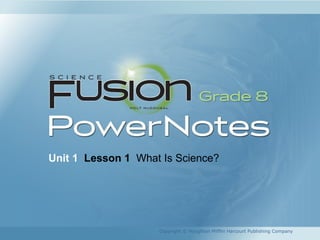
U1 L1 - What is Science?
- 1. Unit 1 Lesson 1 What Is Science? Copyright © Houghton Mifflin Harcourt Publishing Company
- 2. Unit 1 Lesson 1 What Is Science? Indiana Standards Copyright © Houghton Mifflin Harcourt Publishing Company • NOS 8.3 Collect quantitative data with appropriate tools or technologies and use appropriate units to label numerical data. • NOS 8.10 Compare the results of an experiment with the prediction.
- 3. Character Witness Copyright © Houghton Mifflin Harcourt Publishing Company What characterizes science? • Science is the systematic study of natural events and conditions. • There are three main types of science: biology, geology, and physical science. Unit 1 Lesson 1 What Is Science?
- 4. What characterizes science? • Life science, or biology, is the study of living things. • Earth science, or geology, is the study of the surface and interior of Earth. • Physical science is the study of energy and nonliving matter. Physical science includes physics and chemistry. Copyright © Houghton Mifflin Harcourt Publishing Company Unit 1 Lesson 1 What Is Science?
- 5. What characterizes science? • All branches of science have some characteristics in common. • All kinds of scientists must share and discuss their results with others. • All scientific ideas must be testable and reproducible. Copyright © Houghton Mifflin Harcourt Publishing Company Unit 1 Lesson 1 What Is Science?
- 6. What characterizes science? • Scientific evidence must be observable by all scientists. It must not be based on opinions or feelings. • Empirical evidence is observations, measurements, and data that scientists gather to support an explanation. • Scientists commonly use tools to collect data. Copyright © Houghton Mifflin Harcourt Publishing Company Unit 1 Lesson 1 What Is Science?
- 7. “Give me an explanation … ” Copyright © Houghton Mifflin Harcourt Publishing Company What is a scientific explanation? • A scientific explanation provides reasons for how a phenomenon occurs. • Scientific explanations are based on empirical evidence. Therefore, they can be tested. • Science cannot test explanations involving unsupported beliefs or opinions. Unit 1 Lesson 1 What Is Science?
- 8. What is a scientific explanation? • Scientists often start developing an explanation by examining all of the data and empirical evidence they have. • Then they think logically about the evidence and develop a reasonable explanation. • Other scientists test the explanation for themselves. Copyright © Houghton Mifflin Harcourt Publishing Company Unit 1 Lesson 1 What Is Science?
- 9. What is a scientific explanation? • Scientific explanations must explain all available evidence. • If new evidence is discovered, it is compared to the explanation. • If the explanation cannot explain the new evidence, the explanation may be modified. Copyright © Houghton Mifflin Harcourt Publishing Company Unit 1 Lesson 1 What Is Science?
- 10. How is a scientific explanation evaluated? • First, study the empirical evidence. Decide if it supports the explanation. • Second, decide if the explanation is logical and agrees with your other observations. • Third, identify tests you can do to support the idea. • Finally, evaluate the explanation. Copyright © Houghton Mifflin Harcourt Publishing Company Unit 1 Lesson 1 What Is Science?
- 11. Common Habits Copyright © Houghton Mifflin Harcourt Publishing Company What is involved in scientific work? • Science and the people who study it are diverse. However, they have some characteristics in common. • When you show these characteristics, you are thinking like a scientist. Unit 1 Lesson 1 What Is Science?
- 12. What is involved in scientific work? • Scientists make careful observations. They may use their senses or scientific tools to make observations. • Scientists are curious about the world and how it works. • Scientists are creative. They use their imaginations to come up with explanations, experiments, and solutions. Copyright © Houghton Mifflin Harcourt Publishing Company Unit 1 Lesson 1 What Is Science?
- 13. What is involved in scientific work? • Scientists are logical. They use evidence and careful reasoning to develop explanations. • Scientists are skeptical. They do not immediately accept claims. Instead, they ask questions and evaluate the claims. • Scientists are objective. They set aside their feelings and opinions when they evaluate ideas. Copyright © Houghton Mifflin Harcourt Publishing Company Unit 1 Lesson 1 What Is Science?
- 14. “Space Aliens Built the Pyramids” Copyright © Houghton Mifflin Harcourt Publishing Company How is pseudoscience similar to and different from science? • Pseudoscience is beliefs or practices that are mistakenly believed to be based on scientific principles. • Pseudoscience can look like science, but it is not science. Unit 1 Lesson 1 What Is Science?
- 15. How is pseudoscience similar to and different from science? • Both science and pseudoscience can address topics from the natural world. • Pseudoscientific claims can sound logical. They may use technical language or scientific-sounding terms. • Both science and pseudoscience claim to be supported by empirical evidence. Copyright © Houghton Mifflin Harcourt Publishing Company Unit 1 Lesson 1 What Is Science?
- 16. How is pseudoscience similar to and different from science? • Unlike science, pseudoscience does not use accepted scientific methods. • The evidence supporting pseudoscientific claims may be vague, biased, or inaccurate. • Pseudoscientific claims are often not testable. Copyright © Houghton Mifflin Harcourt Publishing Company Unit 1 Lesson 1 What Is Science?
- 17. How is pseudoscience similar to and different from science? • Pseudoscientists may say that any claim that has not been proven false must be true. This is faulty logic. • Scientists offer evidence for their explanations. In contrast, pseudoscientists often ask skeptics to prove their claims false. Copyright © Houghton Mifflin Harcourt Publishing Company Unit 1 Lesson 1 What Is Science?
